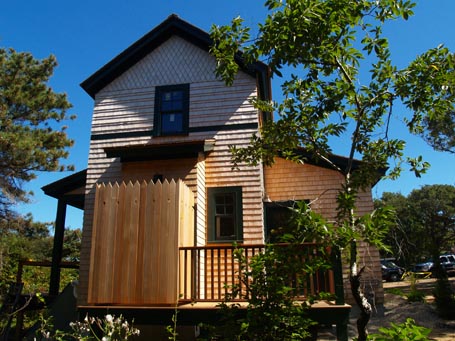
Entries from February 1, 2011 - February 28, 2011
Ask Katie: Kitchen keepers and cost savers in a rental
 cover photo courtesy of Amazon.comQ: We’re planning to build a kitchen in a house we’re renting. The space is in a new addition (roughly 16x22) in a 1930s Sears kit house. Since we are never going to resell the house, we are looking for ways to do this cheaply with an eye towards investing in pieces we can take with us. As an example, I would rather use inexpensive flooring and invest in a good looking rug. Any other ideas?
cover photo courtesy of Amazon.comQ: We’re planning to build a kitchen in a house we’re renting. The space is in a new addition (roughly 16x22) in a 1930s Sears kit house. Since we are never going to resell the house, we are looking for ways to do this cheaply with an eye towards investing in pieces we can take with us. As an example, I would rather use inexpensive flooring and invest in a good looking rug. Any other ideas?
Tim from Brookeville, MD
A: This is a great question for a thrifty Yankee -- especially one who appreciates vintage Sears Roebuck kit houses. I have a few recommendations to offer. First, use and/or convert furniture and/or salvaged items to function as kitchen worksurfaces and storage units. Then, team these with affordable, stock, built-in cabinet cases and open shelves. Finally, round out the kitchen with economical fixture and finish alternatives. When it’s time to move, you could either take some of the items with you or be happy for the savings they offered as you leave them behind.
furniture/salvage accents
For example, sizable farm tables and baking cupboards served their purposes well in kitchens of yore. Why not put them to work in today’s kitchen -- particularly one added to your 30’s home? A sturdy table makes for a great
101 things Katie Hutchison Studio (KHS) has learned designing homes, Part seven of ten
 West Tisbury House: Build second-floor decks into the roofscape, not over open exterior spaceSee Part six of this series here.
West Tisbury House: Build second-floor decks into the roofscape, not over open exterior spaceSee Part six of this series here.
61. Renovation and new construction often approximate the same cost/square foot.
62. Radiant heat is comfortable.
63. There are no stupid questions.
64. Provide pockets of privacy off more public spaces. (See House plans that flow.)
65. Entice occupants to move from space to space with hints of what lies ahead. (See Reading Review: House Thinking.)
66. Incorporate a banquette and/or inglenook if possible. (See Designing inglenooks for today.)
67. Build second-floor decks into the roofscape, not over open exterior space. (See West Tisbury House, above.)
68. Incorporate fresh-air ventilation when construction is super-insulated.
69. Work with general contractors who have worked with architects and respect them.
70. Recycle construction material, appliances, and/or cabinetry where possible.
by Katie Hutchison for House Enthusiast
101 things Katie Hutchison Studio (KHS) has learned designing homes, Part six of ten
 Salem Antique: Kitchen Renovation: Limit overhead kitchen cabinets.See Part five of this series here.
Salem Antique: Kitchen Renovation: Limit overhead kitchen cabinets.See Part five of this series here.
51. Tell a story with a home’s design.
52. Bring the indoors out and the outdoors in. (See Manchester Garage/Garden Room.)
53. Remember that shade and shadow are design tools. (See Brewster Long House.)
54. Express building structure to enhance building legibility.
55. Limit overhead kitchen cabinets. (See Salem Antique: Kitchen Renovation, above.)
56. Include a walk-in pantry, space permitting.
57. Provide ample open shelves. (See Kitchen storage design solutions.)
58. Advise homeowners not to be “penny wise and pound foolish”. (See Don’t overlook intangible value and cost.)
59. Explore, study, and learn from the architectural world around you – near and far. (See Design snapshots.)
60. Incorporate efficient and high-performance appliances and systems.
by Katie Hutchison for House Enthusiast
101 things Katie Hutchison Studio (KHS) has learned designing homes, Part five of ten
 Brewster Long House: Welcome whimsy; express it in the details.See Part four of this series here.
Brewster Long House: Welcome whimsy; express it in the details.See Part four of this series here.
41. Design rooms that flow. (See House plans that flow.)
42. Re-use and/or repurpose it. (See Common Sense Green.)
43. Incorporate finish material, cabinetry, and/or trim which convey craftsmanship and the human spirit. (See Salem Antique: Kitchen Renovation.)
44. Welcome whimsy; express it in the details. (See Brewster Long House, above.)
45. Communicate clearly and frequently. Ask the same of your team.
46. Allow other disciplines to inform your design.
47. Consider a grey-water system.
48. Bill homeowners bi-weekly.
49. Specify adequate site drainage.
50. Distill and celebrate complex order. (See Design snapshot: Shapely balustrade.)
by Katie Hutchison for House Enthusiast















